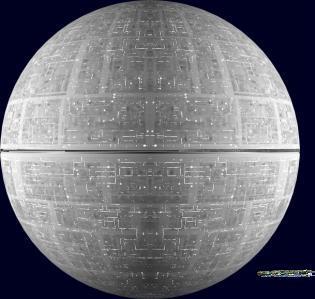
United Galaxies Council. | Neotech-Class Space Factory ("Neotech Factories"). | 
United Galaxies Council. |
|---|
 The UGC needed a large number of basic spacestations to fill a myriad of applications; Building new Robotech Factories was out of the question, but new materials provided a possible solution. Neotech, as it's called, is related to dental acrylic. It's formed into balloons of varying sizes (and occasionally shapes), carefully folded, loaded into crates, then loaded into shuttles; Once in orbit, the shuttle flies to the dark side of the planet, the crates are opened, and the balloon filled with air (a very tiny amount, even just a couple of cubic feet, is more than enough for all but the largest balloons).The filled balloon is then (very carefully) towed into the light side of the planet, where the local star's light hardened the material. But this is only a 'shell' to which steel (or other) girders are attached to form a sphere, around which is built the whole facility.Neotech Factories technically can be anything, but subsidized facilities MUST follow a protocol for use; Up to 15% may be used for "defense purposes" (usually as a factory for defense system, such as Guardian Fighters), at least 25% must be used for fuel production (as hydrogen for hydro-cell engines), and 25% for "economic development" (they do have to pay for themselves, after all).Ship Type: Long Duration Space Habitation/Office VesselCrew (not including connected ships): 1.2 million totalMilitry Crew: 2,2000Civilian Crew/Scientists: 25,500Police/Civil Defense: 15,000MDC By Location: The UGC needed a large number of basic spacestations to fill a myriad of applications; Building new Robotech Factories was out of the question, but new materials provided a possible solution. Neotech, as it's called, is related to dental acrylic. It's formed into balloons of varying sizes (and occasionally shapes), carefully folded, loaded into crates, then loaded into shuttles; Once in orbit, the shuttle flies to the dark side of the planet, the crates are opened, and the balloon filled with air (a very tiny amount, even just a couple of cubic feet, is more than enough for all but the largest balloons).The filled balloon is then (very carefully) towed into the light side of the planet, where the local star's light hardened the material. But this is only a 'shell' to which steel (or other) girders are attached to form a sphere, around which is built the whole facility.Neotech Factories technically can be anything, but subsidized facilities MUST follow a protocol for use; Up to 15% may be used for "defense purposes" (usually as a factory for defense system, such as Guardian Fighters), at least 25% must be used for fuel production (as hydrogen for hydro-cell engines), and 25% for "economic development" (they do have to pay for themselves, after all).Ship Type: Long Duration Space Habitation/Office VesselCrew (not including connected ships): 1.2 million totalMilitry Crew: 2,2000Civilian Crew/Scientists: 25,500Police/Civil Defense: 15,000MDC By Location: |
* Hull
Small Airlocks/Access Hatches (200)
Main Airlock
Outer Hull (per 40ft area)
Interior walls (per 20ft)
External Engineering/Sensor Spokes (8)
Lower Sensor Spoke | 60,000
250 each
1,000
120
40
2,000 each
1,200
| Exterior Central Line Pods (2)
Exterior Rear Pods (2)
Connection Joint/Engineering Section
**Main Engines/Power Plant (2)
** Auxiliary Engines (4)
*** Pin Point Barriers (4) | 6,750 each
10,000 each
8,500
12,500 each
6,000 each
5,000 each |
| Notes:* Depleting the MDC of the hull will essentially destroy the vessel. All internal systems will shut down, including life support and internal gravity. The colony ship itself will be an unsalvageable floating wreck, and any surviving colonists must be rescued quickly or will die from asphyxiation as the remaining atmosphere drains into space.** Depleting the MDC of the main engines will force the ship to rely on its auxiliary engines. Depleting the MDC of the main engines AND auxiliary engines will leave the colony ship adrift in space. If in an atmosphere, the colony ship will crash (destruction of the main engines will render the antigravity system useless due to loss of power).*** The Pinpoint Barriers regenerate at a rate of 1,250 MD per second (2,500 MD per melee round). If destroyed, a barrier will completely regenerate within four seconds (2 melee rounds).Speed and Statistical Data: |
Speed (sublight): 0.16 speed of light (25,600 miles per second).
Speed (Auxiliary Drives): Mach 3.
Space Fold: Equipped.
Planet Bound: Designed to land in a planetary ocean when necessary but not designed to maneuver in an atmosphere. The Einstein-Class is NOT designed to land on the ground. If it does so the landing will inflict 3D6 times 1000 MD damage to the main body of the spacecraft (the lower sensor spoke will be automatically destroyed).
Maximum Range: Unlimited (estimated 30 year life span).
Hull Length: 4,101 feet 1/2 inch (XXm). | Hull Clearance: 4,921 feet 04 inch (XXm).
Length (connector/engineering section): 215 m.
Weight: Approximately 5.5 billion tons standard.
Power System: ORTEC/General Galaxy Main Reactor.
Fold System: ORTEC/Shinnakasu/General Galaxy Advanced Fold System Cluster.
Sublight Drive: ORTEC/Centinel Impulse Drive Cluster.
Gravity Control System: Internal.
Auxiliary Engine: Shinnakasu/Shinsei Industries/Agar Nuclear Pulse Rocket Motor Cluster. |
| Weapons Systems: |
|---|
1. Pinpoint Barrier Defense System: Originally developed by researchers onboard the SDF-01 MACROSS during the First Robotech War, the Pinpoint Barrier System is a standard defense system on board all UN Spacy starships and colony vessels, including the Einstein colony ships. The system generates four small disc-shaped force fields that can be positioned anywhere along the ship to deflect missiles, energy beams or projectiles. Each pinpoint barrier is about 200 ft (61 m) in length and can absorb up to 5,000 MD in damage, which then regenerates within four seconds (2 melee rounds). The barriers can also be layered on top of each other to generate a field which provides 20,000 MDC and can even deflect heavy particle beams (usually).The four barriers are controlled by operators in the command tower of the carrier. These operators are instructed to defend (1) any breaks or weaknesses in the main hull, (2) the engineering section/battle carrier docking section, and (3) the main and auxiliary engines, in that order. The operators primarily concentrate on defending the ship against larger spacecraft and leave defense against attacking Mecha to the VF pilots from the battle carrier.
Purpose: Defense (the pinpoint barrier system cannot be used as a weapon).
Range: Up to 300 feet (91.5 m) from the surface of the vessel.
MDC: Can sustain up to 5,000 MD per round. Regenerates at a rate of 2,500 MD per melee round.
Radius: 200 ft (61 m).
Attacks Per Melee: Can move from one end of the vessel to the other in less than a single round. Trained operators can attempt to block attacks up to 8 times per melee (counts as a parry) and are at +7 to block. Untrained characters can parry up to their number of hand-to-hand attacks with their normal parry bonuses only.
Payload: Nearly inexhaustible. Will work as long as system is functional (see below) and engines are intact. If main engines are destroyed, the barrier will loose power and not function.
Note: If all four barriers are grouped in a single spot they can deflect a heavy particle beam attack, such as the one generated by the Macross Cannon and T'sentraedi command Warships. However, the beam will completely destroy all four barriers and put incredible strain on the pinpoint barrier system, to the point where it may short out. After deflecting an energy beam, roll percentile dice on the table below to determine additional effects/damage.01-15: Lucked out, system will be operational in 1D6 hours.16-30: Minor damage, system will require 4D6 hours to repair.31-45: Major damage, system will require 2D6 times 10 hours to repair (yes, DAYS of work).46-60: Completely destroyed! System can be rebuilt, but will require new parts and 2D6 DAYS of work to replace.61-75: Major damage, system will require 2D6 times 10 hours to repair.76-90: Minor damage, system will require 4D6 hours to repair.91-95: Lucked out, system will be operational in 1D6 hours.96-00: It's a miracle! Trivial damage only, system will be operational again in only 4D6 melee rounds! | 2. Automated Missile Battery (02): 02 of these batteries are on each vessel, on dorsal and one ventral.
Missile Type: Any MRM or LRM
Purpose: Anti-Ship Defense.
MD and Range: Varies by type used.
Rate of Fire: Twice per melee.
Payload: Up to 1,000.
3. Defensive Laser Batteries (20): Each vessel has 20 defensive
laser batteries for anti-missile and meteorite defense.
MD: 5D6 per blast.
Rate of Fire: Per gunners attacks per melee plus bonuses (generally 4 or 5 per melee).
Range: 500 feet.
Payload: Unlimited.
4. Ships, Fighters, Power Armor, and Robots: The various landing bays of the President's Point-Class have enough room and resources to adequately support up to 200 squadrons of VFs, hundreds of shuttles, and even a dozen or so full NUPETIET VERGNITZS-Class Fleet Command Ship internally; However, the typical compliment, based on President's Point herself is a couple squadrons of VT's, 'several' shuttles, and a couple of frigates at any given time. Additionally, the anchor whip can hold up to 2,000 standard Warships.
|
| Features: |
- Long Range Radar: The forward radar array can track and identify up to 10,000 craft simultaneously and has a 5,000 mile range. The radar has a full 180 degrees times 180 degrees times 180 degrees sphere of coverage.
- Scanning Search Radar: The ship has a second scanning radar, with a 90 degrees cone of coverage at 150,000 miles range. This is usually used to extensively scan a given point.
- Data Recorder: Records from the HUD. 5,000 hours of recording available.
- Full range optic sensory suite: Infrared, ultra violet, Magnification, night sight, color filters, thermal imager. Range is about 200 miles for MOST sensors.
- Bridge Display: Displays maps, radar, targeting information, and any OTHER information the OOD/Captain wants directly in front of them.
| - Auto-Pilot: The ship is equipped with a computerized auto-pilot intended to reduce helmsman fatigue. The auto-pilot can be programmed with a single destination or a complex flight plan involving multiple speeds, directions, and destinations. The onboard computer will alert the helmsman and OOD when the ship is near a waypoint (turn), and can also be set to automatically signal when sensors detect objects near her as well as take corrective (or evasive) action up to 15 degrees of assigned course or 2% of assigned speed. The auto-pilot was designed with long intra-system space journeys in mind.
- Space Fold System: For FTL propulsion, the ship is equipped with a Fold System Cluster, capable of propelling her through hyperspace independently of another vessel. The range of the fold drive is theoretically unlimited except by the life expectancy of the spacecraft.
|
Neotech Factory Combat Profile:- 2,000 attacks per melee; However, all of them are restricted to strikes against targets within the range of laser and missile batteries, and are usually against fighters.
- +8 Strike.
|


